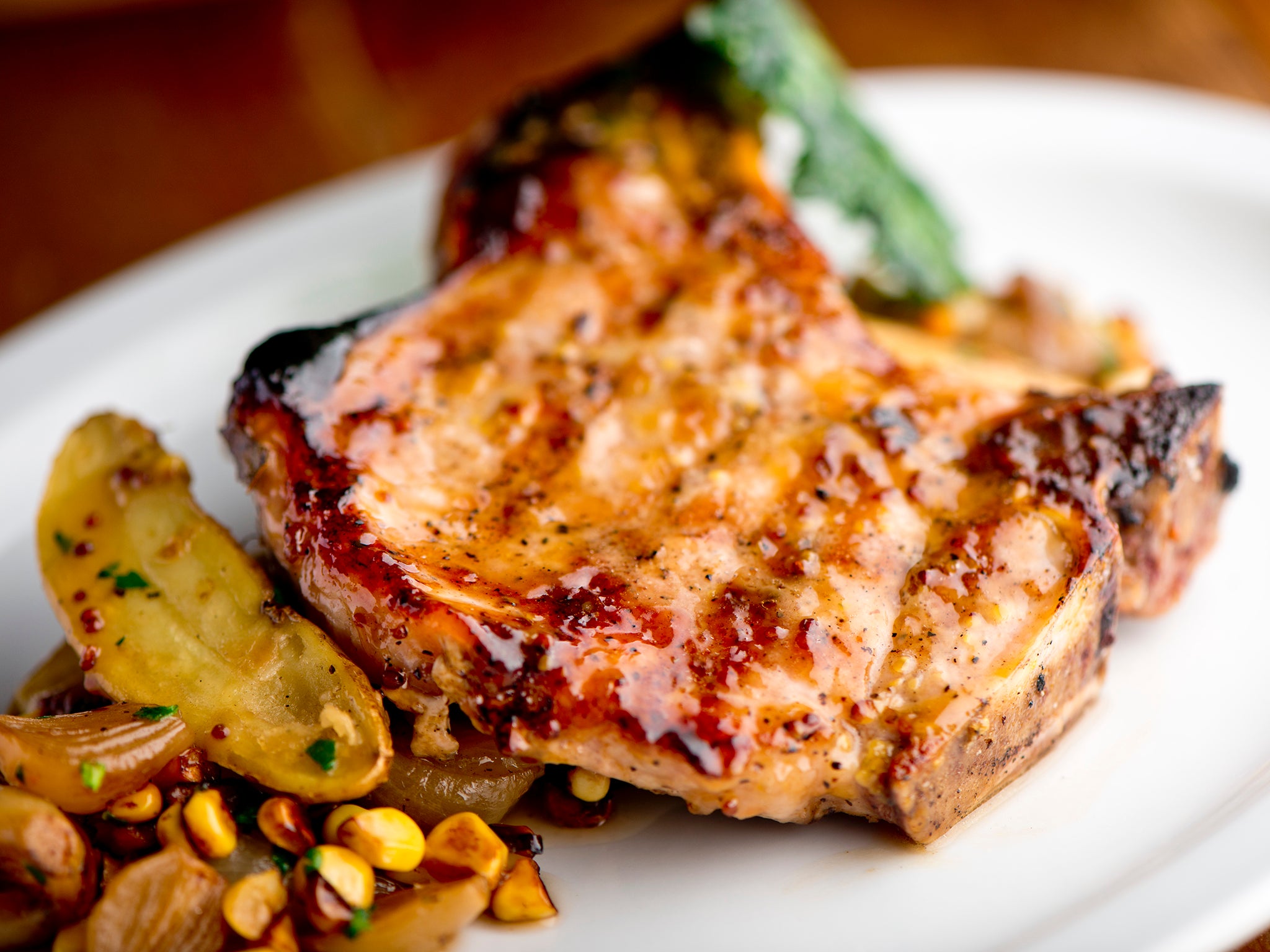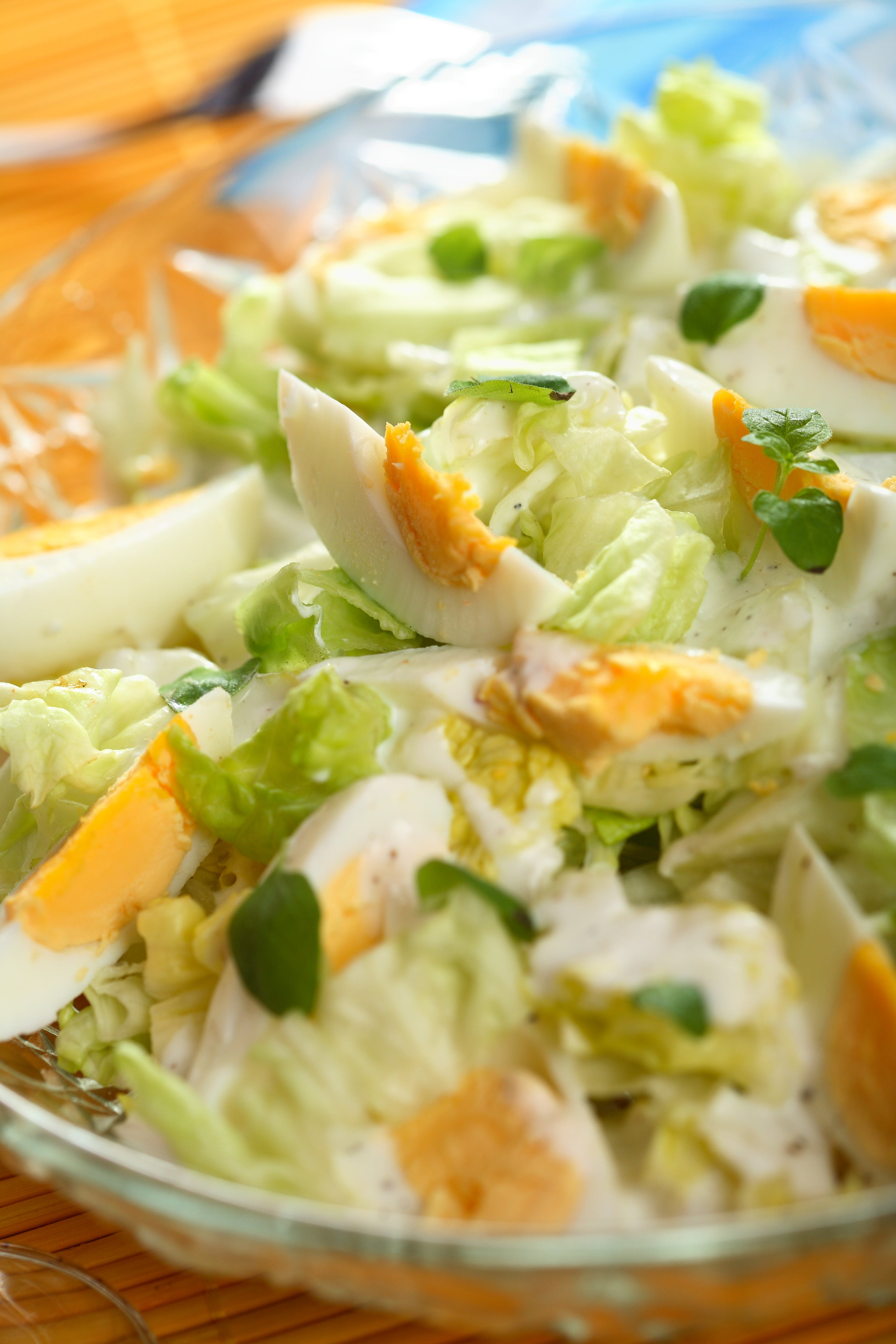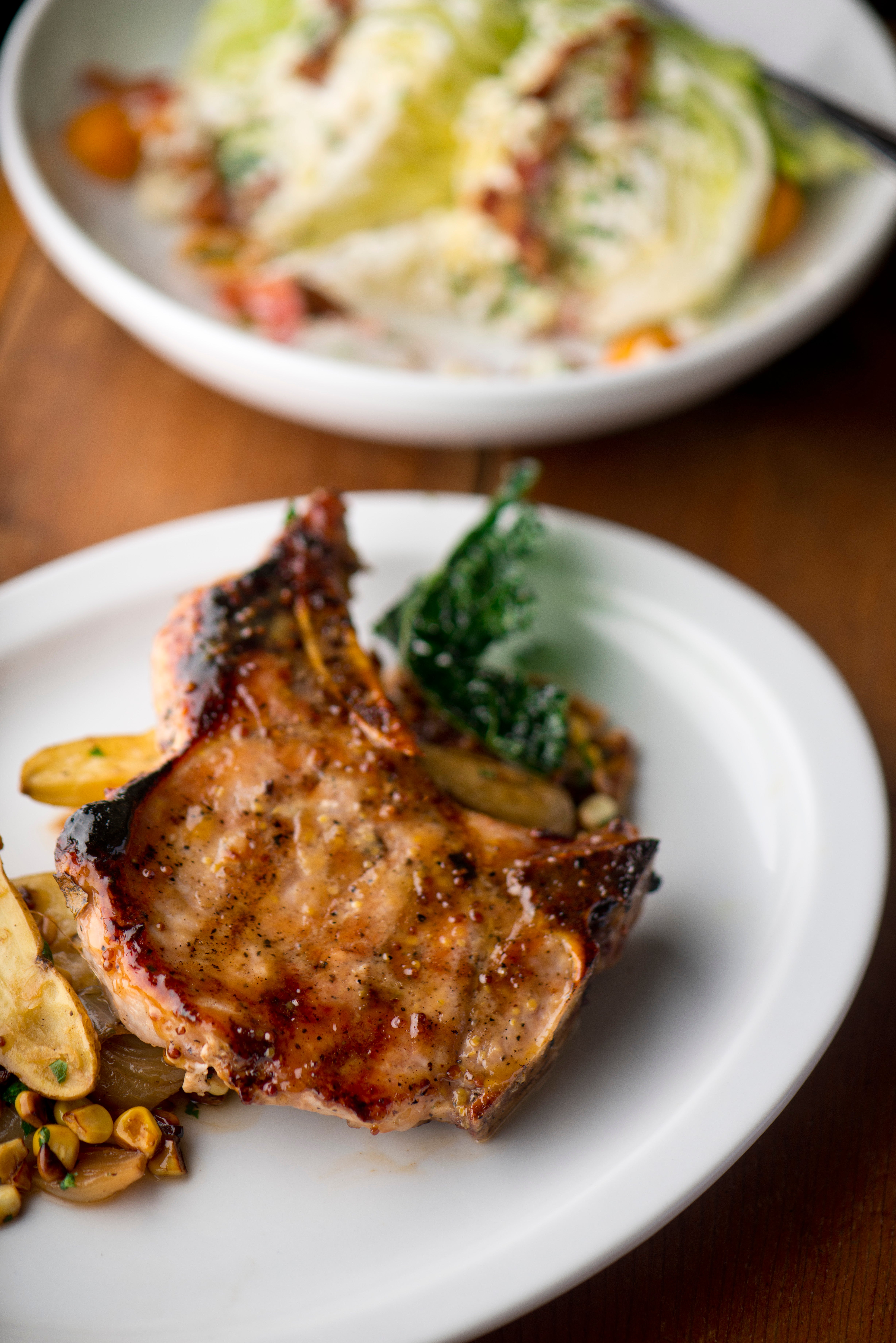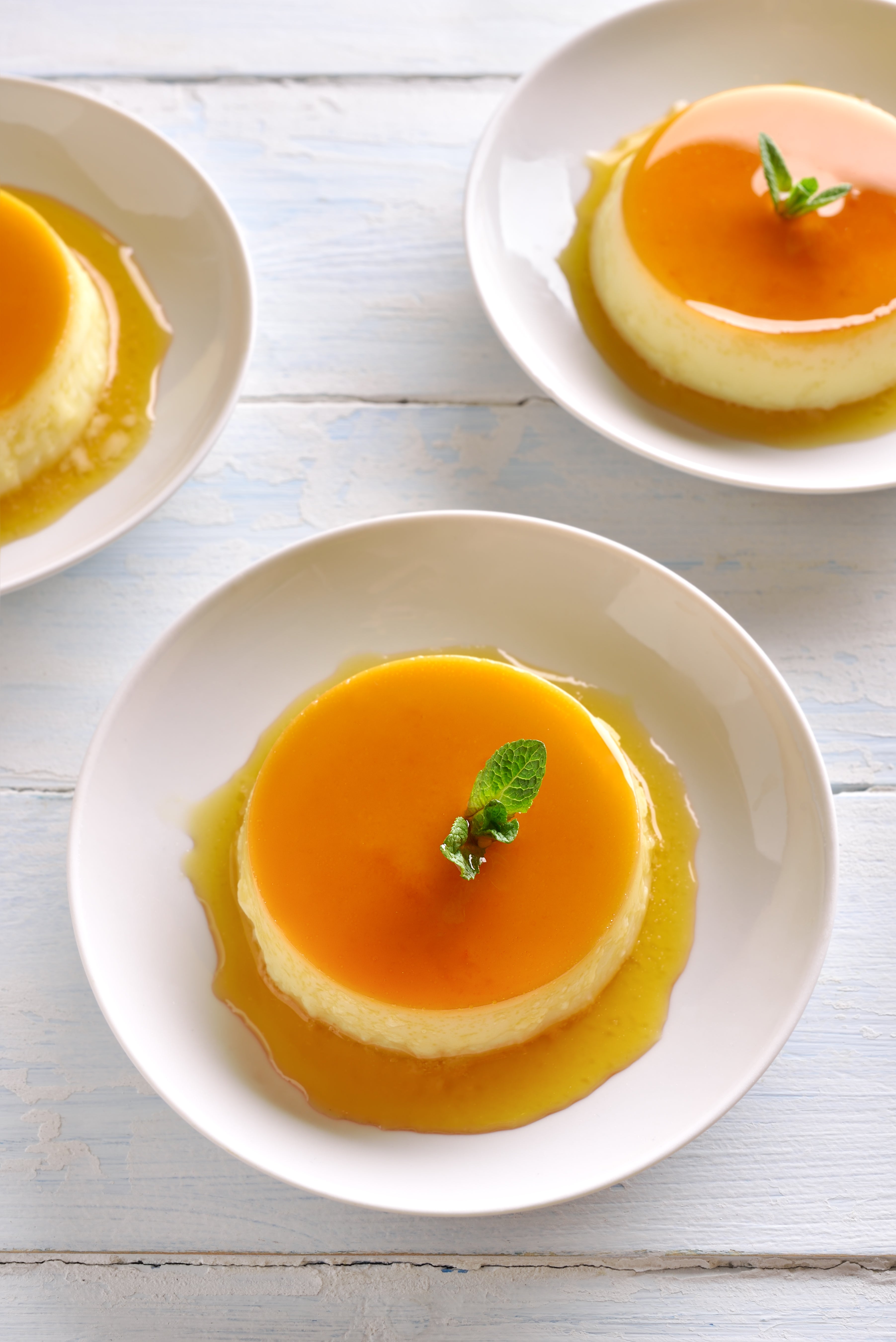A three-course midwinter menu that makes the most of the season
A tangerine flan, prepared in advance, ends this midwinter menu of brightly dressed chicories and rich pork chops from David Tanis

Dessert may cap a meal, but there’s wisdom in putting it first and foremost, particularly when preparing a large dinner. In fact, cooking dessert before anything else is often a wise strategy. The job is then out of the way, so you can concentrate on the savoury dishes. And if you can make the dessert a full day ahead, so much the better.
Enter flan, which is best made a day or two in advance of serving, its flavours improving with time. While flan is often flavoured with orange, this version incorporates that jewel of winter, tangerine, and is somewhat brighter in flavour.
A flan can be made in individual ramekins or in a single large mold. Either way, it’s a bit of a fiddly process. You need to make a caramel first to cover the bottom of the mold. For the best presentation – and flavour – be sure to let the caramel go quite dark, without burning. Once the eggy custard is prepared and poured into the mold, the whole affair is baked in a water bath and refrigerated.
Then it’s on to other, more savoury bits that employ the best of this cool season’s produce: a stellar salad with curly endive, and pork chops with new-crop dates.
A salad is a fine way to begin a meal, no matter the time of year. Sturdy chicories are the salad greens of choice right now – not at all like tender lettuces, but wonderfully fresh tasting. For this menu, curly endive, also known as frisée, fits the bill nicely, alone or in combination with its colourful cousins, Belgian endive, Chioggia, Treviso or speckled Castelfranco radicchio.
All chicories have a slight, pleasant bitterness that stands up nicely to an assertive dressing – in this case, a mustardy vinaigrette. Chopped egg and gruyere add interest (and a little protein). In fact, a large portion of this salad is great on its own, served as a light meal.
Pan-seared center-cut pork chops can be a nice splurge for a main – and what drew me to them was their ease of cooking. But to ensure they remain juicy and succulent, a simple brine comes in handy. Mix it up – it’s just a watery solution of salt, sugar and aromatics – and submerge the chops for a short period or overnight. Even a couple of hours’ brining will achieve tender and tasty results.
For easy effect, sizzle soft medjool dates with butter and sage leaves to spoon over the finished chops, which gives them a blast of sweet-salty flavour (if you can’t find dates, pitted prunes make a good substitute). Parsnips work well as an accompaniment, but so would sweet potato or roasted squash. The date-and-brown-butter treatment tastes good with them, too.
Many elements of this meal can be prepared the day before, so being organised is key. But in return for your foresight, you’ll reap flavourful rewards, and your table-mates will applaud.
Curly endive salad with mustard dressing, egg and gruyere

Serves: 4
Total time: 25 minutes
Ingredients:
4 large eggs, at room temperature
Ice water
3 tbsp red wine vinegar
2 tsp Dijon mustard
1 small garlic clove, grated or mashed to a paste
60ml extra-virgin olive oil
Salt and black pepper
4 large handfuls tender, pale curly endive (from the centre of 2 medium heads), washed and dried
About 60g gruyere
Method:
1. Bring a small pot of water to a boil over high heat. Add eggs (the water should cover them), and return to a boil. Adjust heat so that the water is at a brisk simmer. For a runny yolk, cook for 7 minutes; for a gooey center, cook for 8 minutes; for a slightly moist centre, cook for 9 minutes. Meanwhile, prepare an ice bath.
2. Immediately drain eggs and plunge into ice water to cool. When cool, crack and peel eggs (eggs can be cooked and peeled up to several hours in advance, and refrigerated). Roughly chop eggs into haphazard slices.
3. Put vinegar, mustard and garlic in a small bowl. Whisk with a fork to dissolve. Slowly whisk in olive oil to make a slightly thick dressing. Season to taste with salt and pepper.
4. Put endive in a low, wide salad bowl and sprinkle very lightly with salt. Add dressing to taste and toss well. Transfer greens to individual plates. Top with chopped egg. With a vegetable peeler, shave thin slices of gruyere over each salad.
Pan-seared pork chops with sage, dates and parsnips

Serves: 4
Total time: 30 minutes, plus at least 2 hours’ brining
Ingredients:
70g salt, plus more for boiling
2 tbsp sugar
1 large thyme sprig
4 bone-in pork chops, about 2cm thick (about 900g)
900g parsnips, peeled and cut into 7.6cm sticks
2 tbsp olive oil
4 tbsp salted butter
12 large sage leaves
12 pitted medjool dates, halved
Freshly ground black pepper, to taste
½ lemon, plus more to taste
Method:
1. Brine the chops: put salt and sugar in a large bowl. Whisk in 4 cups water to dissolve. Add thyme sprig and pork chops. Cover and refrigerate for at least 2 hours or up to overnight. When ready to cook, remove chops from brine and pat dry. Discard brine.
2. Heat oven to 175C. Put a large pot of well-salted water over high heat. When it boils, add parsnips and bring to a brisk simmer. Cook until parsnips are tender, 8 to 10 minutes. Drain parsnips and keep warm.
3. Meanwhile, set a large frying pan over medium-high heat and add olive oil. When oil is wavy, sear chops until nicely browned, about 3 minutes per side (work in batches if you don’t have a large frying pan).
4. Transfer chops to a roasting pan or sheet pan in one layer. Bake for 10 to 15 minutes, until meat is 60C when probed with an instant-read thermometer. Remove from oven and let rest while you make the sauce.
5. Wipe out the frying pan and return to medium-high heat. Add butter and let it begin to brown. Add sage leaves and dates, and let sizzle for about a minute. Add pepper and lemon juice, and pull off heat. Taste, and add more pepper or lemon to taste.
6. To serve, place chops and a spoonful of parsnips on warm plates. Spoon butter mixture over chops and parsnips.
Tangerine flan

Serves: 6
Total time: 2 hours, plus at least 4 hours’ refrigerating
Ingredients:
For the caramel:
101g sugar
118g tangerine juice (from 3 to 4 medium tangerines)
For the custard:
473ml half-and-half
101g sugar
2 dried bay leaves
1 small rosemary sprig (optional)
¼ tsp pure vanilla extract
3 large eggs, at room temperature
118ml tangerine juice (from 3 to 4 medium tangerines)
Tangerine segments, for garnish (optional)
Method:
1. Set a rack in the center of the oven, and heat oven to 17C. Have 6 (115g) ramekins ready. Make the caramel: combine sugar and tangerine juice in a small frying pan or saucepan. Set over medium heat, stirring to dissolve sugar, and bring to a simmer.
2. Simmer, stirring occasionally, until mixture begins to thicken, about 5 minutes. Continue simmering until mixture begins to caramelise and brown, stirring or swirling the pan, 5 to 6 minutes more. Let the caramel go as dark as possible without burning, to a deep brown colour, then carefully pour a bit in the bottom of each ramekin, dividing the hot caramel among them evenly. Set ramekins aside at room temperature.
3. Make the custard: put the half-and half and sugar in a medium saucepan, and set over medium-high heat. Add bay leaves, rosemary (if using) and vanilla. Bring to just under a simmer, then turn off heat. Stir to dissolve sugar.
4. In a medium bowl, whisk together eggs and tangerine juice. Whisk in the hot half-and-half mixture a little at a time.
5. Strain the custard through a fine-mesh sieve set over a medium bowl. Set ramekins in a deep baking dish. Fill each ramekin with ½ cup of the strained mixture.
6. Place baking dish on middle rack in the oven. Add hot tap water to baking dish so it comes halfway up the sides of the ramekins. Cover dish tightly with foil and bake until custards set, 25 to 30 minutes. Start checking at 15 minutes. When done, custards should look opaque and just a little wiggly. Insert a paring knife into the center of the flan to test. The knife should come out clean.
7. Carefully remove ramekins from water bath and let cool to room temperature. Wrap and refrigerate for 4 hours or overnight.
8. To serve, run a small knife around the inside edge of each ramekin to loosen the flan. Invert a dessert plate over the ramekin, then flip plate while securing ramekin. Tap or shake ramekin, lift from plate and the flan will release. Spoon any remaining caramel around flan. Garnish with tangerine segments, if desired.
And to drink...
The dates and parsnips will convey a sense of sweetness to this dish, so I’m thinking of both whites and reds that won’t clash or come across as overly austere. Among reds, look for wines that are dry, fresh and fruity, but not overwhelming – some of the new wave garnacha or bobal wines from Spain, perhaps a restrained zinfandel from California or good Côtes-du-Rhônes from France. Other options might include reds from the Languedoc, Bairradas from Portugal, Rosso di Montalcinos from Italy and blaufränkisches from Austria. For whites, I would gravitate toward chenin blancs from the Loire Valley or South Africa, which can be dry yet seem sweet, or maybe a modestly sweet riesling, like a kabinett or spätlese from Germany.
Pairings by Eric Asimov
© The New York Times
Join our commenting forum
Join thought-provoking conversations, follow other Independent readers and see their replies
Comments